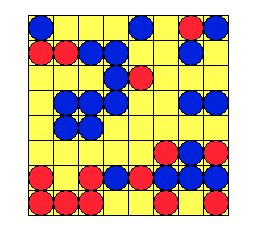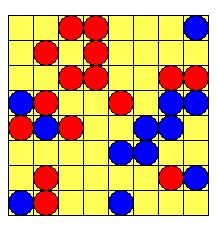- Schelling neighborhood Assignment March 9 (OPEN WITH OPENOFFICE for best results - ABIWORD distorts the format, may not print)
- tk_demo.py, Mr. Torbert's original demo, moving rectangle/oval
- tk_schelling.py, extended demo for this problem. This sample constructs a grid of patches, and each patch can hold 0 or more agents. The overall window size is 800 width, 600 height. Each patch is 25 by 25. This grid has dimensions 200 by 200, which results in an 8 by 8 grid of these patches.
- Example run:

- Example trace using initial density = .5:

with this trace for accuracy of colors on particular patch/grid locations (load with OpenOffice for correct formatting)
- Example run:
- Initial assignment, count the number of neighbors each agent has, then the number of dissimilar agent neighbors
- Determine if an agent is "content" in his/her neighborhood. For now, use these rules, which are considered "moderate" (each agent wants something more than one-third of his/her neighbors to be of the same type). If a person has: ***BLACKBOARD ASSIGNMENT "SCHELLING PRELIMINARY" -
see Schelling preliminary assignment (OPEN WITH OPENOFFICE for best results - ABIWORD distorts the format, may not print)
- one neighbor, it must be the same color
- two neighbors, one must be the same color
- three, four, or five neighbors, two must be his color
- six, seven, or eight neighbors, at least three must be his color
- Determine if an agent is "content" in his/her neighborhood. For now, use these rules, which are considered "moderate" (each agent wants something more than one-third of his/her neighbors to be of the same type). If a person has: ***BLACKBOARD ASSIGNMENT "SCHELLING PRELIMINARY" -
see Schelling preliminary assignment (OPEN WITH OPENOFFICE for best results - ABIWORD distorts the format, may not print)
- Animation shells:
- left/right mouse click demo and Example run - Check agents one at a time by left clicks. When an uncontented agent is found, a right click moves the agent.
- moves in time ticks of .1 sec demo and Example run - check agents one at a time. Move the discontented agents when found. The animation steps at increments of 100/1000 seconds - .1 sec.
- Java shell for Schelling
- FOR A FINAL VERSION: Run experiments testing how quickly (whether or not) the neighborhoods segregate according to variation of parameters for the program. Use as a general form example - Schelling experiment writeup form ***BLACKBOARD ASSIGNMENT "SCHELLING EXPERIMENT"
- Extension assignment if you finish early - Axelrod's model for dissemination of culture.
- Run this sample applet model demonstrating the concept of how cultures interact with each other and become more similar, perhaps.
- Axelrod's paper The Dissemination of Cultures. The model is described on pages 208, 209.
- Construct a simple model for this experiment. Each "patch" can be a culture having a list of traits. The cultures don't move (as in Schelling neighborhood), but they blend traits of neighboring cultures.
- If you're interested, here are more links about this idea
- Netlogo example agent based programs. Also we have Netlogo (maybe not the most current version). Type "netlogo"